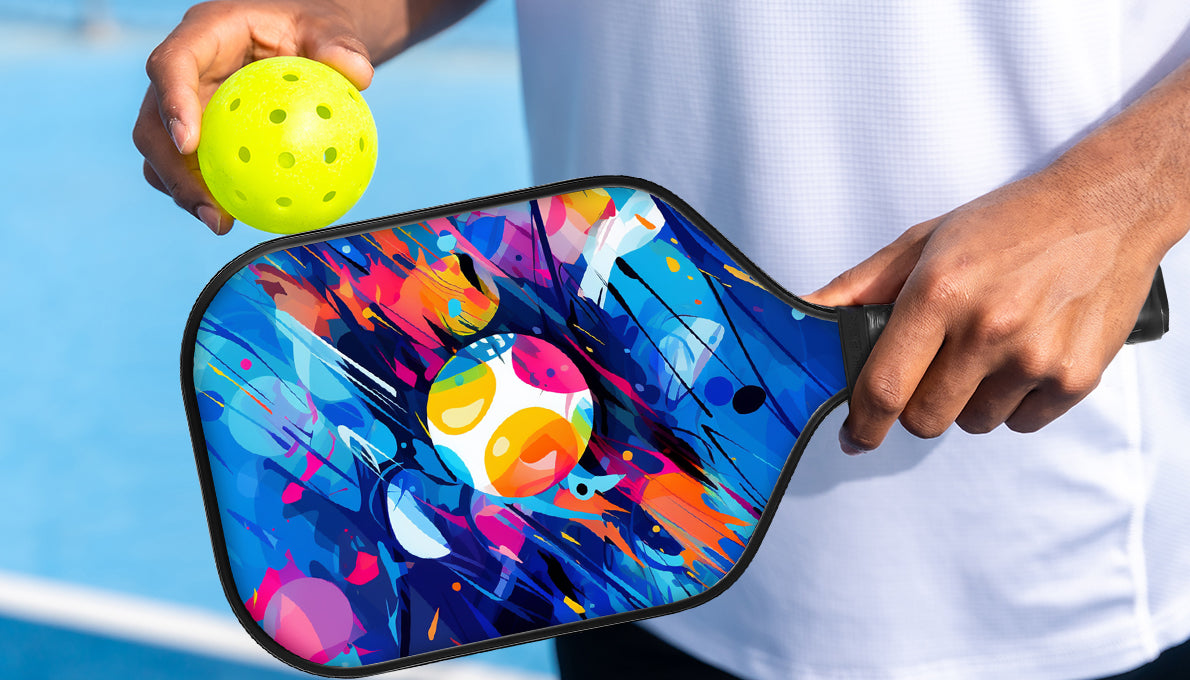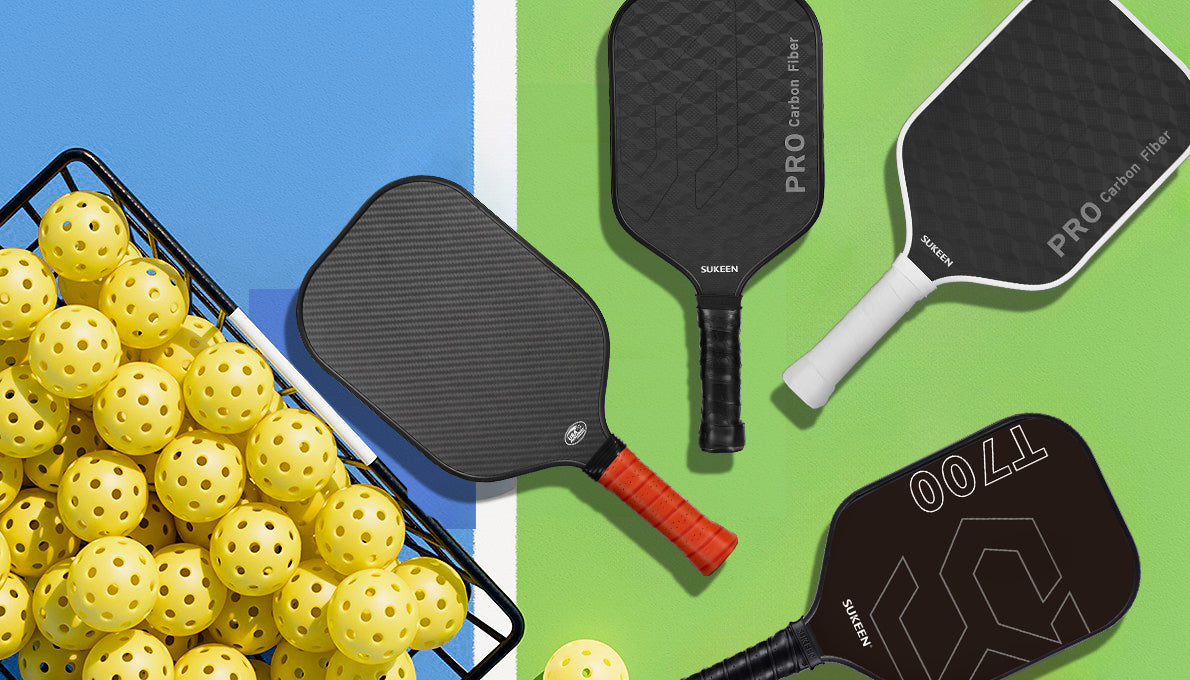Pickleball Paddle Core Construction
Ⅰ. Types of Core MaterialsⅡ. Core Structure and CharacteristicsⅢ. Delamination of Inferior PaddlesⅣ. Professional Advice and Usage Tips
A thorough examination of pickleball racket core materials and construction is essential for any seasoned player. Have you ever delved into the specifics of racket core materials and structures? This guide provides an in-depth look into these components, discussing their benefits and drawbacks, and their impact on your game. Additionally, we’ll highlight SUKEEN's polymer honeycomb core rackets to assist you in making a well-informed decision.
Ⅰ. Types of Core Materials
1. Polymer Honeycomb Core
This material is typically crafted from high-strength, lightweight thermoplastic polymers like polypropylene, and shaped into a honeycomb configuration using advanced techniques. The honeycomb design, inspired by nature’s own honeycomb, is celebrated for its exceptional mechanical properties, delivering high strength and stability with minimal weight. This structural design finds extensive use in fields such as aerospace, construction, and sports equipment, aiming to combine lightweight characteristics with robust strength.
In pickleball, the honeycomb structure significantly reduces the racket's overall weight, enhancing the player's swing speed and agility. It effectively disperses impact forces across the racket, diminishing localized stress and boosting durability and stability. The honeycomb core offers excellent elasticity and control, enabling players to precisely manage both the direction and power of their shots.
However, due to the sophisticated manufacturing process and the high cost of materials, polymer honeycomb core rackets tend to be more expensive. The creation of the honeycomb structure involves stringent processing requirements and precise control during manufacturing to maintain consistency and quality in each honeycomb unit. The production process is intricate, selecting high-grade polymer materials with superior mechanical properties and durability, which are then shaped into honeycomb sheets through extrusion techniques.
Cut to the required size, and then splice multiple pieces of honeycomb sheets into the inner core of the racket through hot pressing or gluing. Then heat treatment is performed to enhance bonding and overall strength.For the manufacturing process, you can click "The Secret of the Thermoformed Pickleball Paddle" to learn more.
2. Foam Core
Foam cores are typically composed of polyurethane foam or similar substances. These materials are recognized for their light weight and commendable elasticity, though they tend to have lower durability. The primary aim of using a foam core is to reduce the racket's overall weight by incorporating lightweight materials, while still offering a degree of elasticity. This design enhances the comfort of striking the ball due to the foam's good elasticity. However, foam materials are relatively delicate and can become damaged over time with extended use, potentially leading to a gradual loss of elasticity.
3. Composite Core
Composite cores are usually made of a combination of multiple materials, such as carbon fiber, fiberglass, and other high-performance composite materials. By combining these materials, composite cores can provide balanced performance. The design concept of composite cores is to combine the advantages of multiple materials to provide more comprehensive performance to meet the needs of different players. By combining multiple materials, composite cores can provide good power, elasticity, and control at the same time. Composite cores provide good power, elasticity, and control, suitable for various playing styles. Due to the complexity of materials and manufacturing processes, the price of composite core rackets is relatively high, but slightly lower than that of single high-end materials.Due to the variety of materials used, composite core rackets may be slightly heavier compared to those made from a single material. High-performance composite materials like carbon fiber and fiberglass are commonly chosen. In contrast to the Polymer Honeycomb Core, composite cores are created by layering multiple materials through lamination technology. This method demands precise control over the thickness and layering sequence of each material. The multi-layered construction improves the racket’s stability and durability. By combining various layers, the laminated design delivers enhanced strength and extended lifespan. Laminated structures are frequently utilized in construction and aerospace due to their superior mechanical properties.There are many different types of rackets, which racket is the best, read "What is the Best Pickleball Paddle?".

Ⅱ. Core Structure and Characteristics
1. The impact of core structure on racket performance
a). Honeycomb structure
Characteristics
The honeycomb design features numerous hexagonal cells, resembling the structure of a honeycomb. Common materials used include polymers (like polypropylene), aluminum, and paper-based composites.
Performance
The geometric shape of the honeycomb structure provides significant elasticity. Each hexagonal unit can independently deform, which helps to disperse impact forces and deliver excellent elasticity and rebound effects.
The high elasticity of the honeycomb structure contributes to a comfortable sensation during ball contact, minimizing vibrations that reach the player's hands.
The laminated construction's multi-layer design offers superior structural stability, ensuring the racket remains steady during ball contact and provides excellent control.
Rackets with a laminated structure deliver a harmonious blend of control and power, making them versatile for various playing styles.Click on "Master the Secret of Spin Ball" to learn the secrets of ball spin.
The laminated design enhances power output by integrating multiple layers of materials. High-strength elements like carbon fiber and fiberglass boost the racket's striking force, making it ideal for power-driven play.
The substantial power generated by the laminated structure makes these rackets particularly well-suited for offensive strategies, enabling players to execute strong attacks during matches.By adjusting the weight of the racket, you can get a different hitting experience. Click "Mastering Pickleball with Lead Tape" to learn how to add weight to different parts of the racket.
Application
Honeycomb structure is often used in high-end and professional-level rackets, providing excellent elasticity and control, suitable for players who pursue high performance and comfortable hitting feel. Like SUKEEN's carbon fiber series rackets, the Honeycomb Structure design is adopted, and the 16mm Polymer Honeycomb Core provides players with the ultimate control.
b). Laminated Structure
Features
The laminated structure is formed by pressing multiple layers of materials together. Common materials include carbon fiber, glass fiber, wood and metal.
Performance
The elasticity of the laminated structure depends on the combination of materials used. Materials such as carbon fiber and glass fiber can provide moderate elasticity, but are usually slightly lower than honeycomb structures.
The laminated structure provides a stable hitting feel, and the combination of different material layers can reduce vibration transmission and provide a good feel.
The multi-layer design of the laminated structure provides higher structural stability, allowing the racket to remain stable when hitting the ball and provide good control.
The racket with a laminated structure provides a balanced performance between control and power, suitable for a variety of playing styles.
The laminated structure provides a stronger power output through the combination of multiple layers of materials. High-strength materials such as carbon fiber and glass fiber can enhance the batting power of the racket and are suitable for power-based play.
Due to the strong power output, the laminated structure racket is particularly suitable for offensive play, helping players to launch powerful attacks in the game.Click "Pickleball Paddle Single Player Game Tips" to learn more about personal hitting tips.
Application
Laminated structures are often used in intermediate, advanced and professional rackets, suitable for players who pursue power output and stable performance, especially for offensive play.
c). Foam Core Structure
Features
The foam core design is typically composed of polyurethane foam or similar substances, often paired with outer materials like glass fiber or carbon fiber.
Performance
The foam core material offers significant elasticity, allowing the racket to deliver a strong rebound effect upon ball contact.
The foam core’s elasticity reduces vibrations during ball hits, resulting in a more comfortable hitting experience.
The foam core structure provides reliable control, making it a suitable choice for beginners and casual players.
Adapt to various playing styles
Foam core rackets can adapt to various playing styles and provide balanced control and elasticity.
The foam core design delivers a moderate level of power, which, while not as forceful as laminated structures, is sufficient for the needs of beginners and recreational players.
Foam core materials are lightweight, resulting in a racket that is easier to handle and ideal for quick swinging techniques.
Application
Foam core structures are commonly found in entry-level and mid-range rackets, making them a good option for beginners and casual players. They offer a balance of elasticity and control at a more affordable price point.
Ⅲ. Delamination of Inferior Paddles
Delamination refers to the failure of the bond between the racket core and the surface material, resulting in the separation of the racket structure. Delamination will seriously affect the performance of the racket, resulting in a poor hitting feel, reduced control, and may even cause the racket to break during use.If you want to know more about layered rackets, you can click "What is a Delaminated Pickleball Paddle?".
1. Honeycomb structure (Polymer Honeycomb Core)
a). Delamination phenomenon
In rackets with a honeycomb structure, delamination often occurs between the honeycomb core and the outer composite materials, such as carbon or glass fiber. Due to the numerous gaps in the honeycomb core, poor adhesive quality or improper handling during use can lead to loose bonding and eventual delamination. When delamination happens, the honeycomb structure fails to effectively transmit impact forces, diminishing the racket's elasticity and rebound capabilities. This instability in the racket’s overall structure can hinder a player’s control over the ball.It is particularly important to know how to judge the quality of a racket. Click "How to Judge Whether a Pickleball Paddle is Good or Bad?" to learn more.
b). Strategies to minimize delamination risk
Choose high-quality materials
Opt for robust and durable polymer materials for the honeycomb core to ensure strong bonding and longevity.
Enhance the bonding process
Utilize high-performance adhesives and maintain consistent temperature and pressure during the hot pressing phase to achieve uniform bonding.
Conduct rigorous quality checks
Implement thorough inspections throughout production to confirm that each honeycomb unit is securely bonded and free from defects.
2. Foam Core
a). Delamination phenomenon
Delamination in foam core rackets typically occurs between the foam core and the outer layer. Foam material is relatively delicate, and prolonged use or intense impacts can lead to the separation of the core from the outer layer. When delamination happens, the foam core loses its ability to deliver optimal elasticity, resulting in a diminished feel during play. This instability affects the racket’s overall performance, compromising both accuracy and control.
b). Ways to reduce the risk of delamination
Select high-quality foam materials
Opt for high-density, high-strength foam to enhance the durability of the core.
Refine the bonding process
Use superior adhesives and ensure that the foam core is uniformly and securely bonded to the outer layer.
Add protective measures
Incorporate an additional protective layer in the racket’s design to minimize the impact of external forces on the foam core.
In addition to these measures, you should also pay attention to the daily cleaning and maintenance of the racket. Click to read "How to clean and maintain pickleball paddle?"
3. Composite Core
a). Delamination
Delamination in composite core rackets generally occurs at the points where different material layers are bonded. Given that composite cores are constructed from multiple material layers, delamination can happen if the interlayer adhesion is insufficient. This issue results in inconsistent performance, impacting both the power and control of your shots. Additionally, the instability of the racket’s structure increases the likelihood of breakage during use.
b). How to minimize the risk of delamination
Select high-performance composite materials
Use composite materials with high strength and durability to improve the adhesion between layers.
Optimize the manufacturing process
Employ advanced lamination techniques to ensure that each layer of material is bonded securely and uniformly.
Implement rigorous quality control
Conduct thorough inspections throughout the production process to guarantee that all material layers are evenly and firmly bonded.
Ⅳ. Professional Advice and Usage Tips
1. Usage tips for professional players
a). Spin ball play
The characteristics of spin balls emphasize the rotation and arc of the ball, which requires precise control and good feel. In this case, I generally recommend that players try using a Polymer Honeycomb Core racket. The high elasticity of the honeycomb structure enables the racket to produce a good rotation effect when hitting the ball. The polymer honeycomb core racket used by SUKEEN provides excellent performance for spin ball play.
b). Power play
The pursuit of powerful shots requires high-intensity hitting power and stability. Using Composite Core will have better performance. The laminated structure provides a stronger hitting power output through the combination of multiple layers of materials. Professional-grade rackets suitable for power play usually use carbon fiber or glass fiber laminated structures.
The perfect implementation of different shots always depends on the performance of the racket to a certain extent. Rack selection is very important. Click to read "How to Choose a Pickleball Paddle?"
2. Maintenance of the inner core material
a). Check the racket condition regularly
Check the racket inner core for delamination or damage regularly, and make sure there are no cracks or wear on the surface.Make sure the grip is intact and provides a good grip.You can learn more from "How to clean and maintain pickleball paddle?".
b). Avoid extreme environments
High temperatures will cause the inner core material to age and reduce the life of the racket. Humid environments will affect the adhesive of the racket and increase the risk of delamination.
c). Store the racket properly
Prevent damage to the racket from heat and humidity. Use a protective bag to store the racket to avoid external physical impact.
Related Articles
What to Look for in a Pickleball Paddle?What Pickleball Paddle Weight is Right for Me?How to Play Pickleball?Mastering Pickleball with Lead TapeMaster the Secret of Spin Ball







